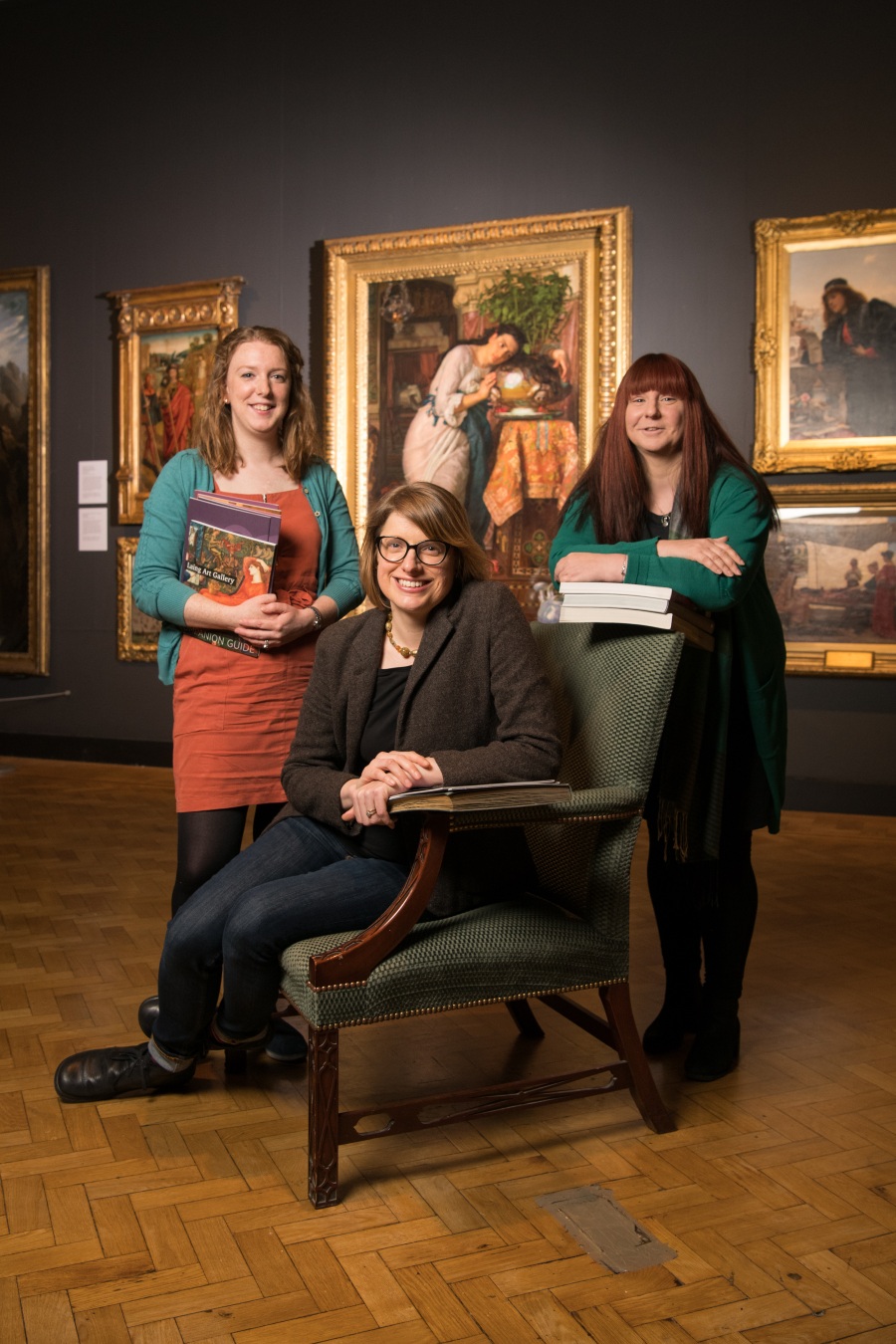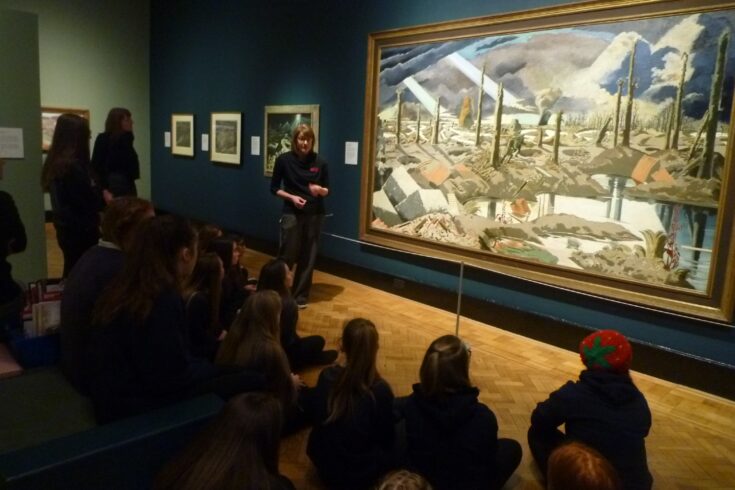The pandemic has foregrounded the crucial role digital platforms can play in providing access to the arts when museums and galleries closed their doors during lockdown. But for all the benefits of online, instant access to the world’s greatest collections and treasures, there remains little substitute for accessing the arts in person.
I’m currently an Arts and Humanities Research Council (AHRC) Innovation Fellow, working in collaboration with my local art gallery, the Laing, in Newcastle-upon-Tyne.
Exploring art collections to enrich learning
Our project, learning through the art gallery, brings GCSE and A-Level English pupils into the gallery for the first time to explore ways in which art collections can enrich their learning.
Interdisciplinarity is commonplace in academia, but at secondary school pupils are taught in siloed ways that make it difficult to see connections beyond individual art works, texts or events.
The project’s workshops are led by colleagues from across English at Northumbria, and to date we’ve experimented with a range of approaches. Close analysis, thematic workshops on gender and tragedy, contextual workshops on Romanticism, politics and Victorian society.
Creative writers have led sessions showing how art can serve as prompts for writing, and we’ve used portraiture as a means of thinking through concepts of character.
Teaching texts through images
Much of our workshop content draws on the Laing’s collections. But we’ve also engaged with temporary exhibitions as well as changing displays.
Often the simplest activities have worked best, and they’re easily adaptable to a range of materials.
For example, when Tate Britain’s Paul Nash exhibition came to the Laing in 2017 to 2018, I led a workshop using The Menin Road. It explored how close analysis of an image helps us to interpret a poem, in this case Wilfred Owen’s ‘Exposure’.
School pupils (and undergrads alike!) often baulk when you ask them to analyse a text. They get scared that they lack the necessary terminology or fear that there’s a single correct answer that they won’t be able to find.
Innate visual learning
Sat in front of an enormous canvas like Menin Road, it was clear that many of the pupils were innate visual learners. And despite a total lack of training they were able to talk confidently and articulately about the painting in front of them.
The sheer size and scale of Menin Road meant that we could experience Nash’s image of desolate and ravaged trenches as a group. Nothing is hidden here; everything feels accessible.
Pupils don’t have to worry that they are reading too slowly or failing to comprehend words that hold the missing pieces of a poem’s jigsaw.
We started with the canvas’s size, its framing of perspective, the colour palette and wider landscape, and then moved on to the specific details which drew them in. We thought about absence, and about what lay beyond our field of vision just outside of the frame.
Paintings and emotions
Statements of emotion and aesthetic judgement felt easier too, with pupils better able to explain how the painting made them feel and why this was the case.
Ask an English student to analyse their response to a literary text or character and they’ll largely commit to a general feeling of like or dislike, but they’ll struggle to tell you why.
The visual is a more immediate form than the textual.
Reading a novel involves a lengthy commitment where a single artwork delivers itself in a moment. In my experience this helps with confidence.
The pupils think the artwork is simply there, and that we are all looking at the same thing. Of course, the more we dig into it, the more we find that’s not true. That we all see different things in Nash’s muddy depths.
Critical thinking
We followed this by reading ‘Exposure’ in front of Nash’s painting, and applied the same approach to thinking through Owen’s poem. The pupils held anthologies, published by the exam board, in which each line of verse is marked up with blue highlighted notes on how to interpret key words and images.
The joy of learning how to read, of how to think and feel, is missing here. So much of the humanities school curriculum seems targeted to provide pupils with answers rather than to provide a space in which they can learn to think and respond for themselves.
Such acts take enormous confidence, but are at the heart of critical thinking.
The confidence problem
Confidence is perhaps the biggest obstacle that we need to overcome in teaching English at school and beyond.

Project team on site at the Laing, left to right: Joy Youngman, Claudine van Hensbergen and Anne Fountain (credit: Northumbria University)
Our project tries to free pupils of the idea that there is a specific answer they need to find.
By looking at primary materials that are entirely new to pupils and which don’t feature in their exams.
Pupils seem happier to use their own language to talk about the artwork on the gallery’s walls.
This helps them to recognise connections between individual works, and indeed across art and literature.
This issue of connection, and of relevance, is also paramount.
Academics are often indignant when told that the general public may not recognise the relevance of arts and humanities subjects to everyday life and society at large.
But if you consider how secondary syllabi teach topics and texts in silos, then you start to see how wider relevance is hard to comprehend.
How can even Hamlet seem important if you don’t think about it beyond the walls of the textbook, beyond its immediate relevance to the ideas and attitudes of Shakespeare’s own day?
Freedom to explore, experience and engage
Pupils need more freedom to explore, to experience, and to engage. We must try harder to remove the fear factor and anxiety in studying texts and encourage enthusiasm and a genuine appreciation of the arts. Key to this is access to those spaces, like galleries, which facilitate this.
Questionnaires collected from the hundreds of local pupils we’ve worked with to date indicates that fewer than 5% of these pupils had visited the gallery previously.
I had expected to find this for schools from neighbourhoods with a higher index of social deprivation, but it was also the case for those serving more affluent areas. After all, most teenagers probably don’t opt to spend their spare time in galleries, but have other priorities.
This makes it even more crucial that we build cultural engagement into the education system itself. And that we use it to show the connection and relevance of the texts pupils study at school to the wider world in which they live.
Find out more
To find out more about this project, or to make an enquiry for a school booking, please visit the learning through the art gallery website.
We’d love you to share this article on social media to help spread the word about this new initiative and bring us into dialogue with other interested parties.
Top image: Pupils workshop on Paul Nash’s painting The Menin Road (1919). Credit: Claudine van Hensbergen




